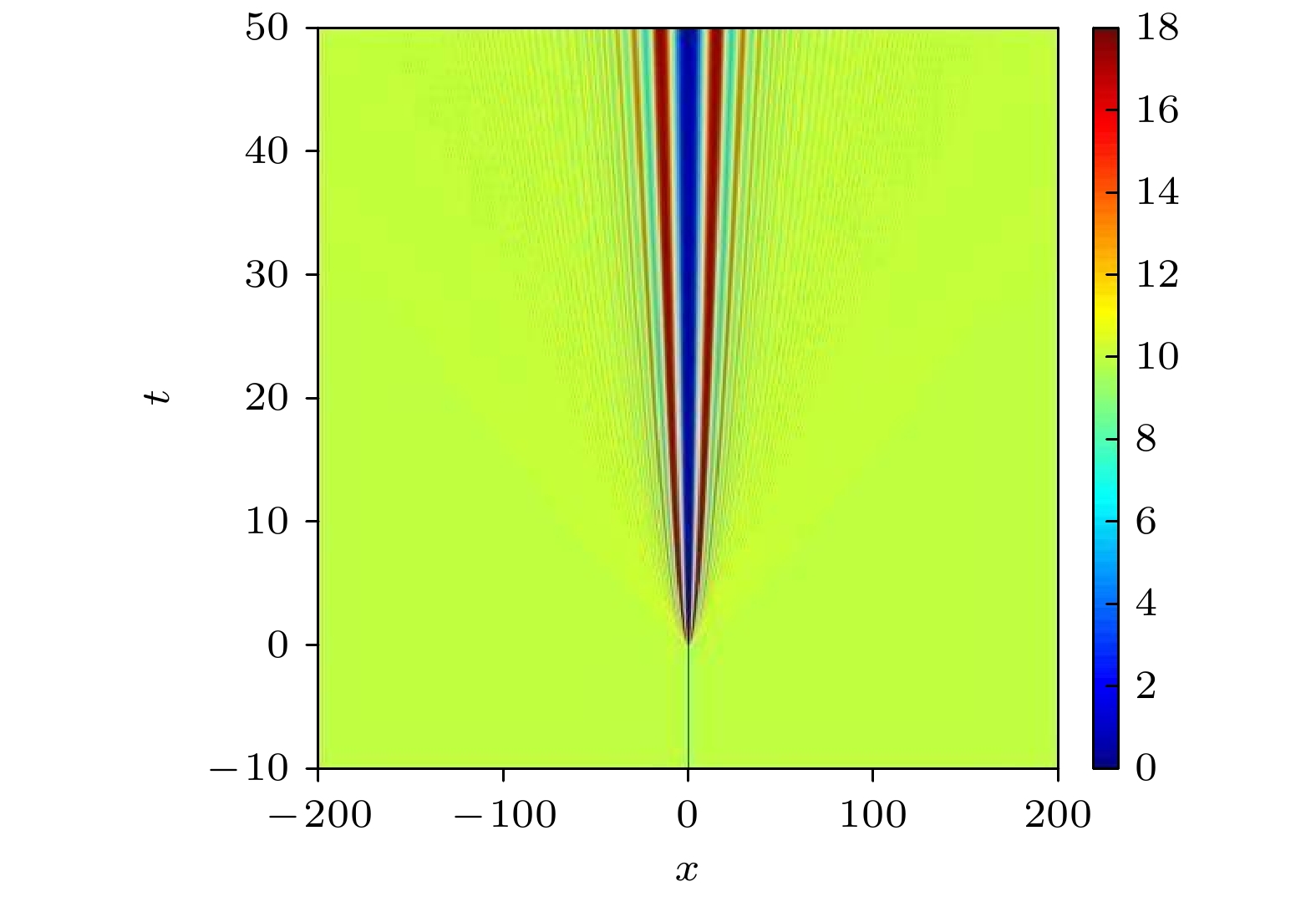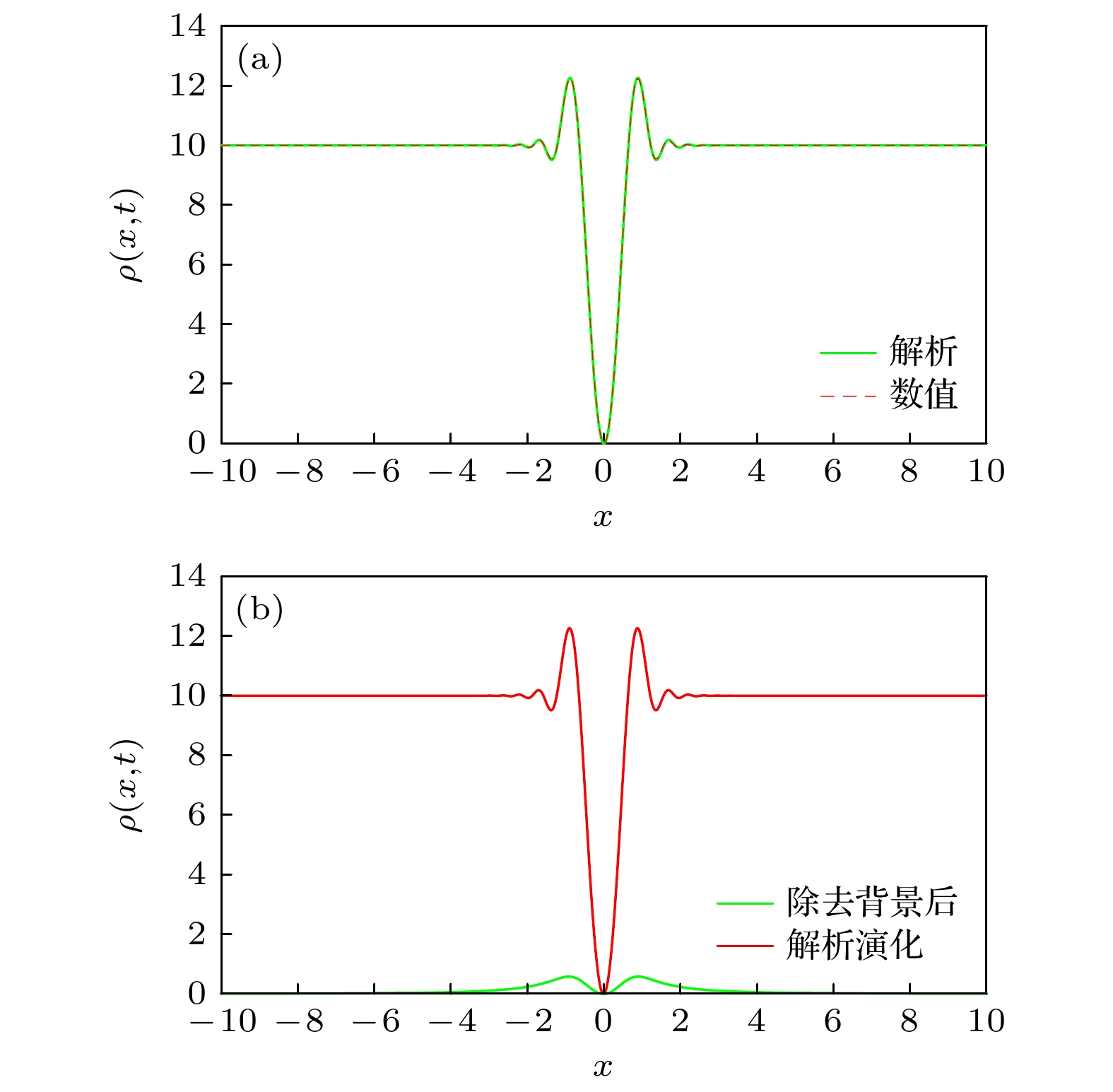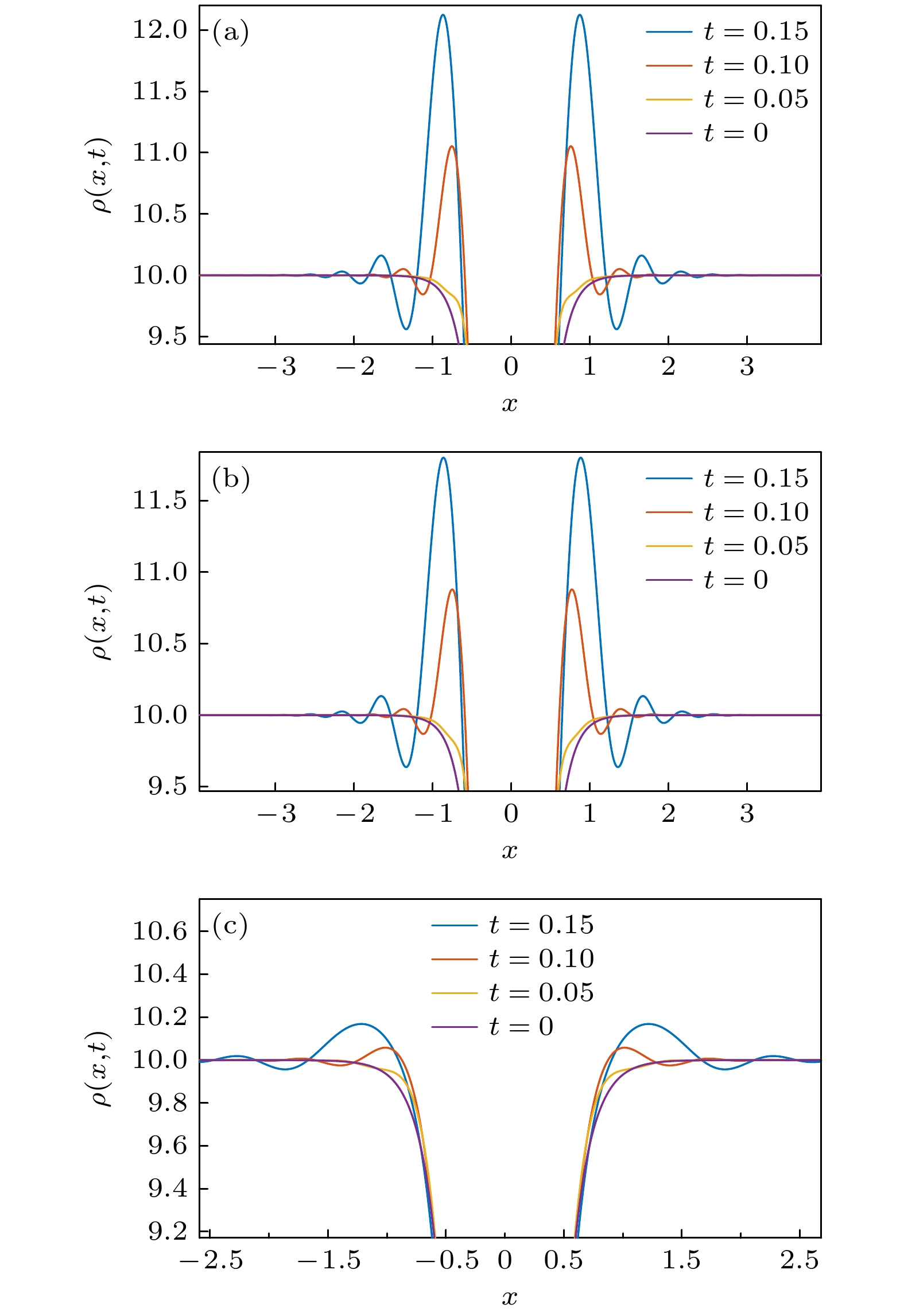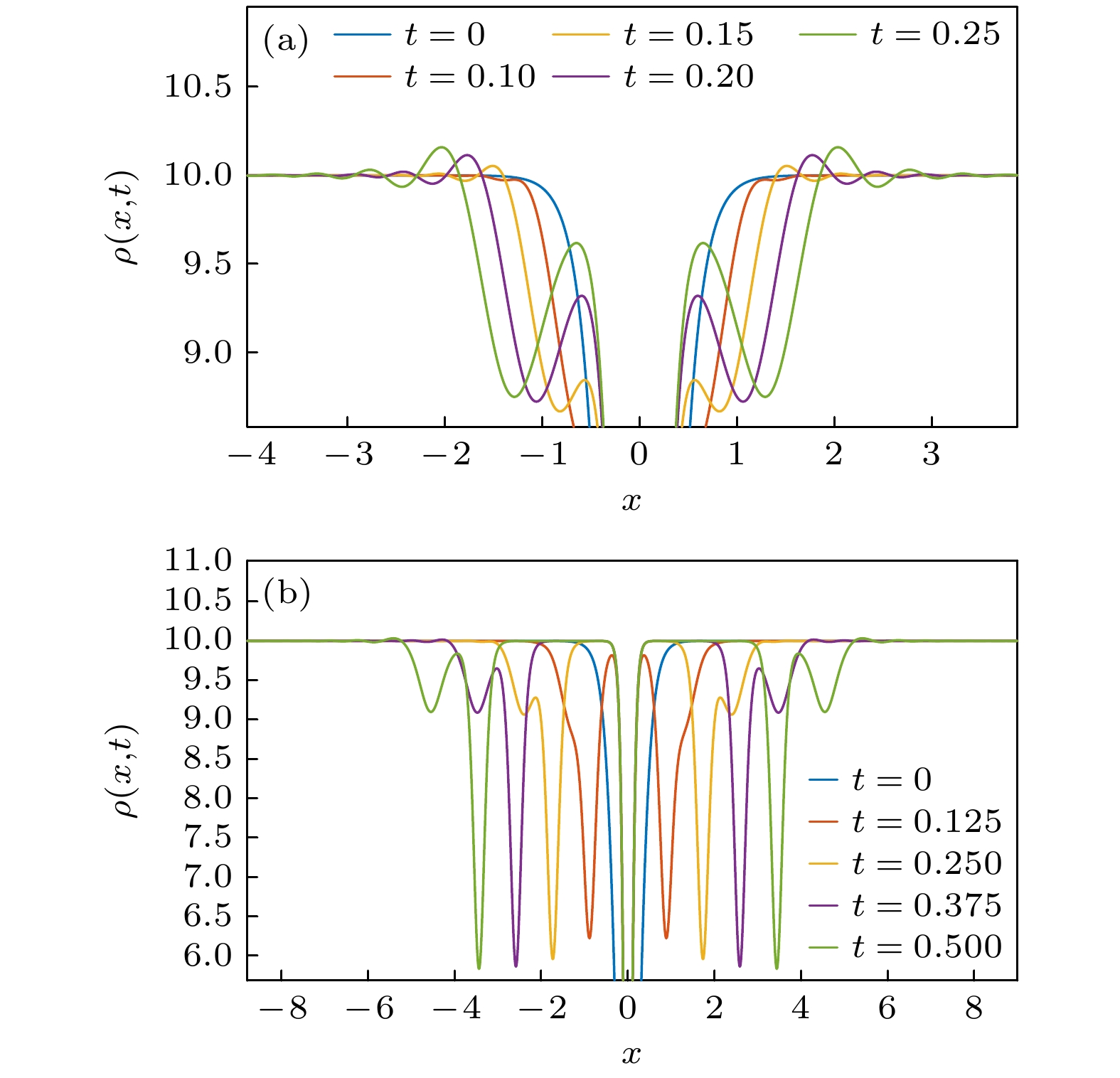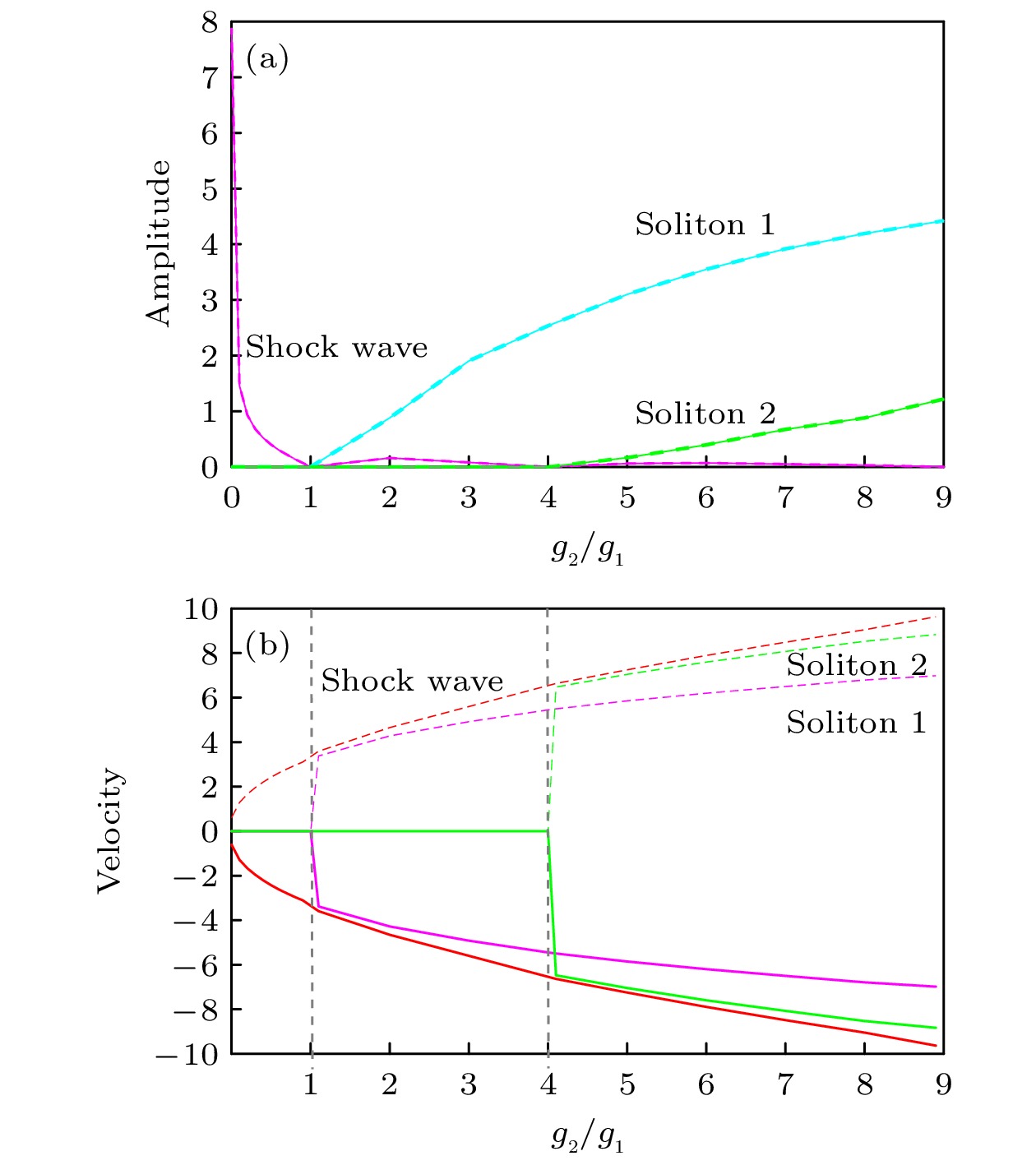-
系统性地探讨了通过淬火相互作用在初态包含暗孤子的玻色-爱因斯坦凝聚体中产生量子冲击波的可能性及其内禀机制. 在淬火至无相互作用极限下, 解析得到了初始静止孤子的后续动力学, 发现了冲击波的存在, 并通过量子相干效应加以解释. 在淬火至有限相互作用下, 通过数值求解Gross-Piatevskii方程也发现了冲击波现象, 并且分析了不同情形: 往弱相互作用侧淬火时得到的冲击波与无相互作用情形类似; 往强相互作用侧淬火时得到的冲击波伴随着孤子的劈裂, 且两者存在同步变化关系. 进一步探究了冲击波的特性, 包括其振幅、速度, 并得到了其随淬火相互作用强度变化的全景图谱. 这一工作为实验上实现和观测冲击波提供了理论指导.The Bose-Einstein condensate (BEC) formed by ultracold atomic gases provides an ideal platform for studying various quantum phenomena. In this platform, researchers have explored in depth the important equilibrium and steady phenomena including superfluidity, vortices, and solitons, and recently started to study nonequilibrium problems. In a classical system, nonequilibrium problems, such as explosion, usually occur together with shock waves, which is presented when the explosion speed is larger than the local sound speed. For BEC systems which possess quantum properties, how to produce and understand the shock waves becomes a hot research topic. In this work, we systematically discuss the possibility of quantum shock wave and its essential mechanism in a one-dimensional BEC initially containing dark solitons through quenching interactions. When the system is quenched to the limit of non-interaction, we analytically obtain the post-quench dynamics of initially immobile dark solitons, and find the existence of shock wave, which can be explained through the quantum interference effect. When the system is quenched to finite interaction, we find similar phenomena through numerically solving the Gross-Pitaevskii equation, and analyze different situations. When the system is quenched to a finite weaker interaction, the situation is similar to a non-interaction case; when the system is quenched to a stronger interaction, the shock wave is accompanied by the splitting of the initial soliton, and the two objects can synchronously change; specifically when the quenched ratio of strength is an integer squared, the shock wave disappears, and the soliton is split perfectly. We further explore the properties of the shock wave including its amplitude and speed, and obtain the full scenario as the quenched interaction varies. This work provides theoretical guidance for realizing and measuring shock wave in experiment.
-
Keywords:
- shock wave /
- soliton /
- quench /
- Bose-Einstein condensate
[1] Anderson M H, Ensher J R, Matthews M R, Wieman C E, Cornell E A 1995 Science 269 198
 Google Scholar
Google Scholar
[2] Bradley C C, Sackett C A, Tollett J J 1995 Phys. Rev. Lett. 75 1687
 Google Scholar
Google Scholar
[3] Davis K B, Mewes M O, Andrews M R 1995 Phys. Rev. Lett. 75 3969
 Google Scholar
Google Scholar
[4] Matthews M R, Anderson B P, Haljan P C 1999 Phys. Rev. Lett. 83 2498
 Google Scholar
Google Scholar
[5] Burger S, Bongs K, Dettmer S 1999 Phys. Rev. Lett. 83 5198
 Google Scholar
Google Scholar
[6] Strecker K E, Partridge G B, Truscott A G 2003 New J. Phys. 5 73
 Google Scholar
Google Scholar
[7] Busch T, Anglin J R 2001 Phys. Rev. Lett. 87 010401
 Google Scholar
Google Scholar
[8] Hamner C, Chang J J, Engels P 2011 Phys. Rev. Lett. 106 065302
 Google Scholar
Google Scholar
[9] Yan D, Chang J J, Hamner C 2011 Phys. Rev. A 84 053630
 Google Scholar
Google Scholar
[10] Kevrekidis P G, Frantzeskakis D J 2016 Rev. Phys. 1 140
 Google Scholar
Google Scholar
[11] Hoefer M A, Chang J J, Hamner C 2011 Phys. Rev. A 84 041605
 Google Scholar
Google Scholar
[12] Yan D, Chang J J, Hamner C 2012 J. Phys. B: At. Mol. Opt. 45 115301
 Google Scholar
Google Scholar
[13] Danaila I, Khamehchi M A, Gokhroo V 2016 Phys. Rev. A 94 053617
 Google Scholar
Google Scholar
[14] Chen P J, Gurtin M E 1971 Phys. Fluids 14 1091
 Google Scholar
Google Scholar
[15] Serrin J 1959 Mathematical Principles of Classical Fluid Mechanics (Berlin: Springer) p125
[16] Smoller J, Temple B 2003 Proc. Natl. Acad. Sci. U.S.A. 100 11216
 Google Scholar
Google Scholar
[17] Quintanilla R, Straughan B A 2004 Math. Phys. Sci. 460 1169
 Google Scholar
Google Scholar
[18] Morro A 2006 Math. Comput. Modell. 43 138
 Google Scholar
Google Scholar
[19] Carusotto I, Artoni M, La Rocca G C 2001 Phys. Rev. Lett. 87 064801
 Google Scholar
Google Scholar
[20] Akhmediev N, Karlsson M 1995 Phys. Rev. A 51 2602
 Google Scholar
Google Scholar
[21] Carusotto I, Hu S X, Collins L A 2006 Phys. Rev. Lett. 97 260403
 Google Scholar
Google Scholar
[22] Rothenberg J E, Grischkowsky D 1989 Phys. Rev. Lett. 62 531
 Google Scholar
Google Scholar
[23] Couton G, Maillotte H, Chauvet M 2004 J. Opt. B: Quantum Semiclassical Opt. 6 223
 Google Scholar
Google Scholar
[24] Wan W, Jia S, Fleischer J W 2007 Nat. Phys. 3 46
 Google Scholar
Google Scholar
[25] Jia S, Wan W, Fleischer J W 2007 Phys. Rev. Lett. 99 223901
 Google Scholar
Google Scholar
[26] Barsi C, Wan W, Sun C 2007 Opt. Lett. 32 2930
 Google Scholar
Google Scholar
[27] Ghofraniha N, Conti C, Ruocco G 2007 Phys. Rev. Lett. 99 043903
 Google Scholar
Google Scholar
[28] Conti C, Fratalocchi A, Peccianti M 2009 Phys. Rev. Lett. 102 083902
 Google Scholar
Google Scholar
[29] Ghofraniha N, Amato L S, Folli V 2012 Opt. Lett. 37 2325
 Google Scholar
Google Scholar
[30] Fatome J, Finot C, Millot G 2014 Phys. Rev. X 4 021022
 Google Scholar
Google Scholar
[31] Dutton Z, Budde M, Slowe C 2001 Science 293 663
 Google Scholar
Google Scholar
[32] Simula T P, Engels P, Coddington I 2005 Phys. Rev. Lett. 94 080404
 Google Scholar
Google Scholar
[33] Hoefer M A, Ablowitz M J, Coddington I 2006 Phys. Rev. A 74 023623
 Google Scholar
Google Scholar
[34] Chang J J, Engels P, Hoefer M A 2008 Phys. Rev. Lett. 101 170404
 Google Scholar
Google Scholar
[35] Hoefer M A, Engels P, Chang J J 2009 Physica D 238 1311
 Google Scholar
Google Scholar
[36] Meppelink R, Koller S B, Vogels J M 2009 Phys. Rev. A 80 043606
 Google Scholar
Google Scholar
[37] Damski B 2004 J. Phys. B: At. Mol. Opt. Phys. 37 85
 Google Scholar
Google Scholar
[38] Pérez-García V M, Konotop V V, Brazhnyi V A 2004 Phys. Rev. Lett. 92 220403
 Google Scholar
Google Scholar
[39] Kamchatnov A M, Gammal A, Kraenkel R A 2004 Phys. Rev. A 69 063605
 Google Scholar
Google Scholar
[40] Joseph J A, Thomas J E, Kulkarni M 2011 Phys. Rev. Lett. 106 150401
 Google Scholar
Google Scholar
[41] Joseph R R, Rosales-Zárate L E C, Drummond P D 2018 Phys. Rev. A 98 013638
 Google Scholar
Google Scholar
[42] Mo Y C, Kishek R A, Feldman D 2013 Phys. Rev. Lett. 110 084802
 Google Scholar
Google Scholar
[43] Taylor R J, Baker D R, Ikezi H 1970 Phys. Rev. Lett. 24 206
 Google Scholar
Google Scholar
[44] Pitaevskii L P 1961 Sov. Phys. JETP 13 451
[45] Gross E P 1961 Nuovo Cimento 20 454
 Google Scholar
Google Scholar
[46] Gross E P 1963 J. Math. Phys. 4 195
 Google Scholar
Google Scholar
[47] Kamchatnov A M 2019 Phys. Rev. E 99 012203
 Google Scholar
Google Scholar
[48] Damski B 2004 Phys. Rev. A 69 043610
 Google Scholar
Google Scholar
[49] Simmons S A, Bayocboc Jr F A, Pillay J C 2020 Phys. Rev. Lett. 125 180401
 Google Scholar
Google Scholar
[50] Pethick C J, Smith H 2008 Bose–Einstein Condensation in Dilute Gases (Cambridge: Cambridge University Press) pp159−162, 216−222
[51] Olshanii M 1998 Phys. Rev. Lett. 81 938
 Google Scholar
Google Scholar
[52] Chin C, Grimm R, Julienne P 2010 Rev. Mod. Phys. 82 1225
 Google Scholar
Google Scholar
[53] Gamayun O, Bezvershenko Y V, Cheianov V 2015 Phys. Rev. A 91 031605
 Google Scholar
Google Scholar
-
图 1 一维BEC中初始高斯波包的演化过程, 纵轴是密度
$\rho(x, t)= {\vert\varPsi(x, t)\vert}^2$ (a)$\varPsi(x, 0)=\varPsi_0+2\exp(-x^2/\alpha^2)$ ; (b)$\varPsi(x, 0)=\varPsi_0-2\exp(-x^2/\alpha^2)$ , 其中$\varPsi_0=3$ , 高斯波包的宽度$\alpha=2$ Fig. 1. Evolution of an initial Gaussian packet in a one-dimensional BEC. The vertical axis is density
$\rho(x, t) = $ $ {\vert\varPsi(x, t)\vert}^2$ : (a)$\varPsi(x, 0)=\varPsi_0+2\exp(-x^2/\alpha^2)$ ; (b)$\varPsi(x, 0)= $ $ \varPsi_0-2\exp(-x^2/\alpha^2)$ .$\varPsi_0=3$ and the width of Gaussian wave packet$\alpha=2$ .图 2 从
$t = -10$ 至$t= 0$ , 暗孤子在凝聚体中稳定演化, 其中背景密度$n = 10$ , 相互作用强度$g_1 = 1$ . 而在$t = 0$ 时刻对系统进行了淬火, 将相互作用强度突变至$g_2= 0$ , 此后在暗孤子两侧出现对称的激发, 这些激发以恒定速度向两侧运动, 中间孤子宽度变大Fig. 2. From
$t=-10$ to$t = 0$ , the dark soliton evolves stably in the condensate, in which the background density is$n=10$ and the interaction intensity$g_1=1$ . At$t=0$ , the system is quenched, and the interaction intensity suddenly changes to$g_2=0$ . After that, symmetric excitations appear on both sides of the dark soliton, which move to both sides at a constant speed, and the width of the intermediate soliton increases.图 3 (a)淬火后暗孤子演化至
$t = \pi/20$ 时刻数值与解析对照图, 可以发现两者完全符合; (b)$t = \pi/20$ 时刻, 除去背景暗孤子淬火后的演化与不除去背景的比较, 在除去背景后冲击波消失Fig. 3. (a) When the dark soliton evolves to
$t = \pi/20$ after quenching, it can be found that they are completely consistent with the analytical comparison chart; (b) at$t = \pi/20$ , the evolution of dark soliton after quenching with background removed is compared with that without background removed, and the shock wave disappears after background removed.图 4 淬火强度在
$0\leqslant g_2/g_1 < 1$ 范围时冲击波的形成对比 (a)淬火至无相互作用强度下, 即$g_2/g_1=0$ , 可以观察到在背景之上有波包的隆起, 并且伴随着与背景的振荡; (b)相互作用强度淬火前后比值$g_2/g_1 = 0.1$ , 除了淬火比值不同外其他都与图(a)相同($n=10,\;g_1=1$ ); (c)相互作用强度淬火前后比值$g_2/g_1=0.9$ , 其他参数与(a), (b)两图相同Fig. 4. Comparison of shock wave formation when quenching strength is
$0\leqslant g_2/g_1 < 1$ : (a) For quenching to the strength without interaction, that is$g_2/g_1 = 0$ , it can be observed that there is a bump above the background, accompanied by oscillation with the background; (b) ratio of interaction strength before and after quenching is$g_2/g_1 = 0.1$ , values of other parameters are the same as those in panel (a) ($n = 10,\; g_1 = 1,\; m = 1$ ,$\hbar = 1$ ); (c) ratio of interaction strength before and after quenching is$g_2/g_1 = 0.9$ , and values of other parameters are the same as those in panels (a) and (b).图 5 淬火强度
$ g_2/g_1 > 1 $ 时冲击波的形成对比 (a)淬火相互作用强度为$ g_2/g_1 = 2 $ ; (b)淬火相互作用强度为$ g_2/g_1 = 8 $ , 其他参数与4.1节相同Fig. 5. Comparison of shock wave formation when quenching strength is
$ g_2/g_1 > 1 $ : (a) Quenching interaction strength is$ g_2/g_1 = 2 $ ; (b) quenching interaction strength is$ g_2/g_1 = 8 $ , and other parameters are the same as those in the section 4.1.图 6 淬火强度
$g_2/g_1=4$ 与$ g_2/g_1=9 $ 时孤子完美劈裂 (a)淬火相互作用强度为$ g_2/g_1=4 $ 时在原孤子两侧各完美劈裂出1个灰孤子; (b)淬火相互作用强度为$ g_2/g_1=9 $ 时在原孤子两侧各完美劈裂出两个灰孤子. 可以观察到完美劈裂情况下除了孤子并没有其他激发Fig. 6. When the quenching strength is
$ g_2/g_1=4 $ and$ g_2/g_1=9 $ , the soliton splits perfectly: (a) When the quenching interaction intensity is$ g_2/g_1=4 $ , a gray soliton is perfectly split on both sides of the original soliton; (b) when the quenching interaction intensity is$ g_2/g_1 =9 $ , two gray solitons are split perfectly on both sides of the original soliton. It can be seen that in the case of perfect splitting, there is no excitation except soliton.图 7 淬火后孤子与冲击波的振幅、速度随淬火强度的变化 (a)冲击波最高点振幅以及劈裂出的孤子深度与相互作用强度淬火比值关系, 虚线为左侧, 实线为右侧, 两者完全重合; (b) 速度与相互作用强度淬火比值关系, 红色线所描述的是冲击波, 绿色和粉丝的线是劈裂出的孤子. 在原孤子的左侧为负, 右侧为正
Fig. 7. Changes of amplitude and velocity of soliton and shock wave after quenching: (a) Quenching ratio relationship between the peak amplitude of shock wave, the depth of split soliton and the interaction strength. The dashed line is on the left side and the solid line is on the right side, which are completely coincident; (b) quenching ratio relationship between velocity and interaction strength. The red line describes shock wave, and the green and vermicelli lines are split solitons. It is negative on the left side and positive on the right side of the original soliton.
-
[1] Anderson M H, Ensher J R, Matthews M R, Wieman C E, Cornell E A 1995 Science 269 198
 Google Scholar
Google Scholar
[2] Bradley C C, Sackett C A, Tollett J J 1995 Phys. Rev. Lett. 75 1687
 Google Scholar
Google Scholar
[3] Davis K B, Mewes M O, Andrews M R 1995 Phys. Rev. Lett. 75 3969
 Google Scholar
Google Scholar
[4] Matthews M R, Anderson B P, Haljan P C 1999 Phys. Rev. Lett. 83 2498
 Google Scholar
Google Scholar
[5] Burger S, Bongs K, Dettmer S 1999 Phys. Rev. Lett. 83 5198
 Google Scholar
Google Scholar
[6] Strecker K E, Partridge G B, Truscott A G 2003 New J. Phys. 5 73
 Google Scholar
Google Scholar
[7] Busch T, Anglin J R 2001 Phys. Rev. Lett. 87 010401
 Google Scholar
Google Scholar
[8] Hamner C, Chang J J, Engels P 2011 Phys. Rev. Lett. 106 065302
 Google Scholar
Google Scholar
[9] Yan D, Chang J J, Hamner C 2011 Phys. Rev. A 84 053630
 Google Scholar
Google Scholar
[10] Kevrekidis P G, Frantzeskakis D J 2016 Rev. Phys. 1 140
 Google Scholar
Google Scholar
[11] Hoefer M A, Chang J J, Hamner C 2011 Phys. Rev. A 84 041605
 Google Scholar
Google Scholar
[12] Yan D, Chang J J, Hamner C 2012 J. Phys. B: At. Mol. Opt. 45 115301
 Google Scholar
Google Scholar
[13] Danaila I, Khamehchi M A, Gokhroo V 2016 Phys. Rev. A 94 053617
 Google Scholar
Google Scholar
[14] Chen P J, Gurtin M E 1971 Phys. Fluids 14 1091
 Google Scholar
Google Scholar
[15] Serrin J 1959 Mathematical Principles of Classical Fluid Mechanics (Berlin: Springer) p125
[16] Smoller J, Temple B 2003 Proc. Natl. Acad. Sci. U.S.A. 100 11216
 Google Scholar
Google Scholar
[17] Quintanilla R, Straughan B A 2004 Math. Phys. Sci. 460 1169
 Google Scholar
Google Scholar
[18] Morro A 2006 Math. Comput. Modell. 43 138
 Google Scholar
Google Scholar
[19] Carusotto I, Artoni M, La Rocca G C 2001 Phys. Rev. Lett. 87 064801
 Google Scholar
Google Scholar
[20] Akhmediev N, Karlsson M 1995 Phys. Rev. A 51 2602
 Google Scholar
Google Scholar
[21] Carusotto I, Hu S X, Collins L A 2006 Phys. Rev. Lett. 97 260403
 Google Scholar
Google Scholar
[22] Rothenberg J E, Grischkowsky D 1989 Phys. Rev. Lett. 62 531
 Google Scholar
Google Scholar
[23] Couton G, Maillotte H, Chauvet M 2004 J. Opt. B: Quantum Semiclassical Opt. 6 223
 Google Scholar
Google Scholar
[24] Wan W, Jia S, Fleischer J W 2007 Nat. Phys. 3 46
 Google Scholar
Google Scholar
[25] Jia S, Wan W, Fleischer J W 2007 Phys. Rev. Lett. 99 223901
 Google Scholar
Google Scholar
[26] Barsi C, Wan W, Sun C 2007 Opt. Lett. 32 2930
 Google Scholar
Google Scholar
[27] Ghofraniha N, Conti C, Ruocco G 2007 Phys. Rev. Lett. 99 043903
 Google Scholar
Google Scholar
[28] Conti C, Fratalocchi A, Peccianti M 2009 Phys. Rev. Lett. 102 083902
 Google Scholar
Google Scholar
[29] Ghofraniha N, Amato L S, Folli V 2012 Opt. Lett. 37 2325
 Google Scholar
Google Scholar
[30] Fatome J, Finot C, Millot G 2014 Phys. Rev. X 4 021022
 Google Scholar
Google Scholar
[31] Dutton Z, Budde M, Slowe C 2001 Science 293 663
 Google Scholar
Google Scholar
[32] Simula T P, Engels P, Coddington I 2005 Phys. Rev. Lett. 94 080404
 Google Scholar
Google Scholar
[33] Hoefer M A, Ablowitz M J, Coddington I 2006 Phys. Rev. A 74 023623
 Google Scholar
Google Scholar
[34] Chang J J, Engels P, Hoefer M A 2008 Phys. Rev. Lett. 101 170404
 Google Scholar
Google Scholar
[35] Hoefer M A, Engels P, Chang J J 2009 Physica D 238 1311
 Google Scholar
Google Scholar
[36] Meppelink R, Koller S B, Vogels J M 2009 Phys. Rev. A 80 043606
 Google Scholar
Google Scholar
[37] Damski B 2004 J. Phys. B: At. Mol. Opt. Phys. 37 85
 Google Scholar
Google Scholar
[38] Pérez-García V M, Konotop V V, Brazhnyi V A 2004 Phys. Rev. Lett. 92 220403
 Google Scholar
Google Scholar
[39] Kamchatnov A M, Gammal A, Kraenkel R A 2004 Phys. Rev. A 69 063605
 Google Scholar
Google Scholar
[40] Joseph J A, Thomas J E, Kulkarni M 2011 Phys. Rev. Lett. 106 150401
 Google Scholar
Google Scholar
[41] Joseph R R, Rosales-Zárate L E C, Drummond P D 2018 Phys. Rev. A 98 013638
 Google Scholar
Google Scholar
[42] Mo Y C, Kishek R A, Feldman D 2013 Phys. Rev. Lett. 110 084802
 Google Scholar
Google Scholar
[43] Taylor R J, Baker D R, Ikezi H 1970 Phys. Rev. Lett. 24 206
 Google Scholar
Google Scholar
[44] Pitaevskii L P 1961 Sov. Phys. JETP 13 451
[45] Gross E P 1961 Nuovo Cimento 20 454
 Google Scholar
Google Scholar
[46] Gross E P 1963 J. Math. Phys. 4 195
 Google Scholar
Google Scholar
[47] Kamchatnov A M 2019 Phys. Rev. E 99 012203
 Google Scholar
Google Scholar
[48] Damski B 2004 Phys. Rev. A 69 043610
 Google Scholar
Google Scholar
[49] Simmons S A, Bayocboc Jr F A, Pillay J C 2020 Phys. Rev. Lett. 125 180401
 Google Scholar
Google Scholar
[50] Pethick C J, Smith H 2008 Bose–Einstein Condensation in Dilute Gases (Cambridge: Cambridge University Press) pp159−162, 216−222
[51] Olshanii M 1998 Phys. Rev. Lett. 81 938
 Google Scholar
Google Scholar
[52] Chin C, Grimm R, Julienne P 2010 Rev. Mod. Phys. 82 1225
 Google Scholar
Google Scholar
[53] Gamayun O, Bezvershenko Y V, Cheianov V 2015 Phys. Rev. A 91 031605
 Google Scholar
Google Scholar
计量
- 文章访问数: 7755
- PDF下载量: 121
- 被引次数: 0













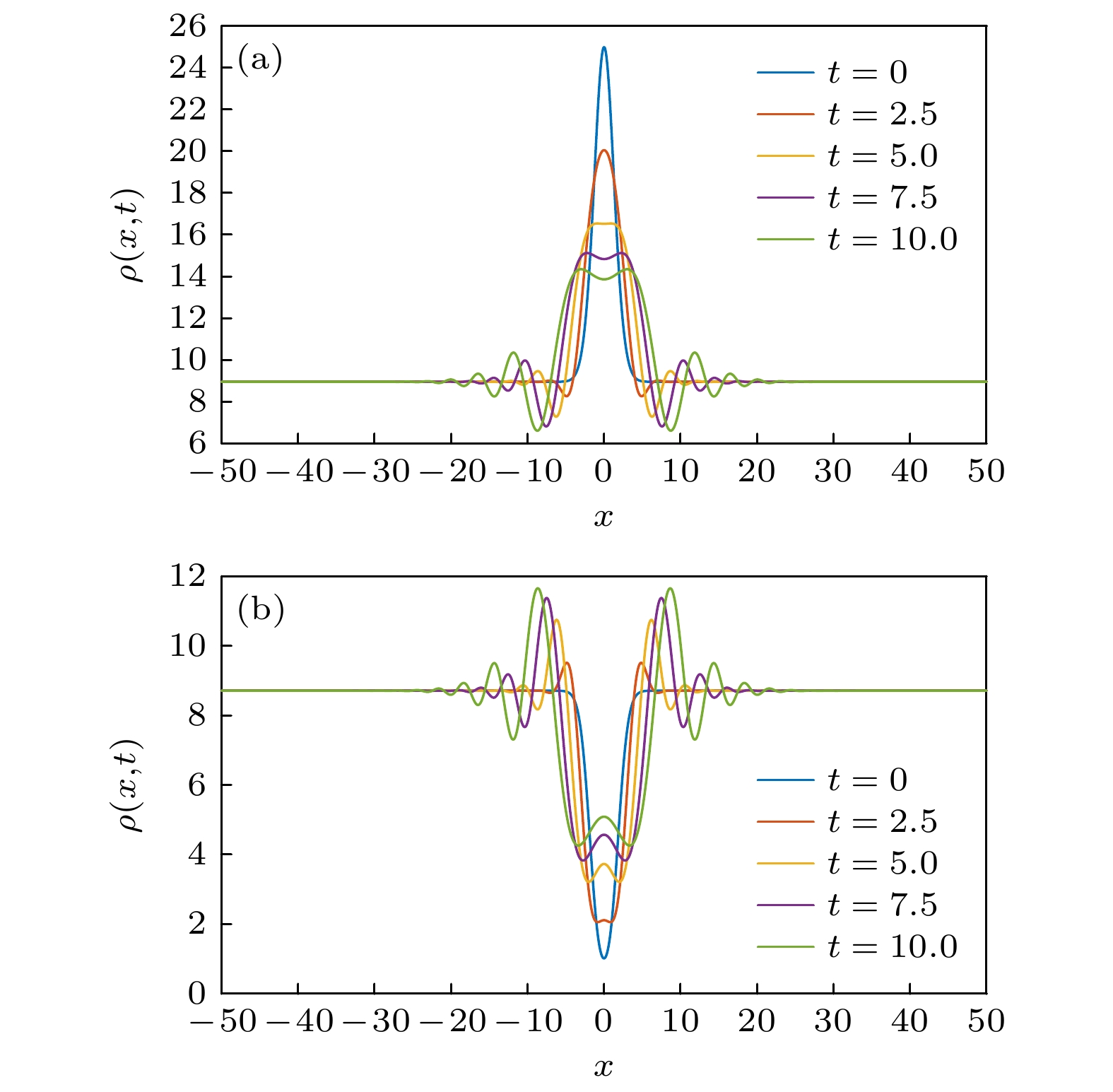












 下载:
下载:
